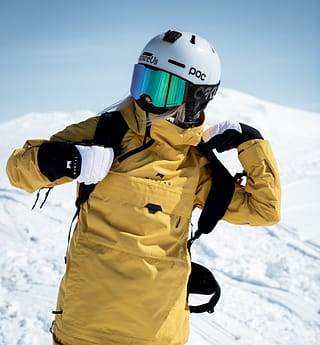Everything you need to know about snow gloves
If you're looking for some new snow gloves, there are a couple things to know! Choices galore and tech-talk abound, this guide is everything you need to make the right choice this coming season.

Snowboarding and skiing gloves come in all shapes and sizes, and finger arrangements, too. From lightweight cross-country gloves to hardcore full-leather backcountry mittens, the range of available gloves has never been larger, and if you’re staring down the barrel of your next purchase, and can’t figure out why one pair costs so little and another costs ten times as much, then you’ll be glad you stumbled onto this article.
Below, we’ll be going over everything we know about snowboard gloves or ski gloves, to help you make the right decision when it comes to grabbing your new pair. The ‘type’ is broken down into three categories, which are gloves (separate fingers), trigger mittens (separated index finger only), and full mittens (no finger separation). Then, you’ll have the option between cross country gloves, park glove, resort gloves, and backcountry gloves, which will probably not be labeled, but can often be discerned from the level of warmth and waterproofing they offer! But let’s not get ahead of ourselves here. Read on to learn all about snow gloves, one piece of handy info at a time.

Mittens vs. gloves
So the first thing to consider with snow gloves is if you should go for mittens or gloves. There is no right or wrong, but depending on your preferences there might be a better choice for you.
What does a mitten glove have that a glove does not?
Warmth, pretty much. A mitten glove keeps your hands warmer than a glove. This is because your fingers are close together and not separated like in a glove. This makes it much easier for your hands to keep the warmth up, more than you probably think.
What ups does the traditional glove have?
That would be sleight of hand. Since your fingers are separated, performing tasks with the gloves on will be easier.
Conclusion
If you know that your hands easily get cold, mittens might be the best choice for you. But if you do a lot of tasks were freely moving fingers will make life easier, the glove is for you.

Keeping your hands dry and warm
At first glance, it might sound like having a pair of warm and waterproof snow gloves would do the trick. But that can actually make your hands wet and cold instead. Yup, strange world we live in.
This is because warmth, waterproofing and breathability are three factors that play together. And having a nice blend of all three ingredients are needed to keep your hands dry and warm.
Fun fact
Most of the times your hands get wet. It is because of sweat, this actually plays a much bigger role then rain or snow.
And what makes your hands sweat? That’s right, warmth. And it is only a question of time until that sweat gets cold and makes your hands both wet and cold. That is why a warm glove can be contra productive.
So to keep your hands dry and warm, you should go for a pair of gloves that have good breathability, good enough waterproofing to keep the wet from the elements out. And just warm enough to keep you warm but not sweaty.
This might sound hard since the weather also plays a role in how warm your gloves should be. But it does not need to be that complicated.

Make your gloves more temperature flexible
Using liners or thinner gloves under your gloves is a great way to keep the warmth up. And if you start to feel sweaty, you can just remove the liners.
That way, you can go for a pair of gloves that can you can use in most temperatures. And when it is cold, add liners. When it is warm, remove the liners.
Get the correct size
Having gloves that are the wrong size is a quite unpleasant experience. It is not only uncomfortable but will also make your hands colder.
Size does matter
Faulty Fitted Snow Gloves Will Be Uncomfortable And Make Your Hands Cold.
Your fingers should be close to touching or barely touching the end of the glove. And you should be able to tighten/buckle your snow or ski boots without removing the glove.

5 Pro tips for warmer hands
- If you start to feel cold. Tighten your knuckles and fist inside the glove and let your body heat help you to get back up in warmth
- Put your gloves on before you leave the house. Having warm hands before you put the gloves on will help to keep warm
- Use liners under your glows. Doing this will keep your hands warmer and make your gloves more temperature flexible
- Do not hold your poles to tight, this will lessen the blood flow in your fingers and make it harder to keep warm
- Do not get cold in the first place, might sound obvious. But it is actually much harder to get warm than to keep warm. So avoid anything that will make your hand's cold while in the slopes
Common questions and answers about snow gloves
How to wash ski gloves?
This will differ a bit depending on what type of glove and the material. But read up on the washing instruction label to be sure of what machine washing program to use. Also, wash the gloves in a mesh bag so they do not rip in the machine. Do not turn the gloves inside out.
How to dry ski gloves?
Avoid to out your gloves directly on a heat source. Instead, let them hang in a dry and warm environment for several hours. The first thing you do after you come back home from the slopes should be to let your gloves dry (and all other gear).
How should ski gloves fit?
Glove or mitten, the fit should be the same. It should fit snugly around your hand and allow for your fingers to just touch the end of the gloves. This will give more dexterity and warmth.
What is good insulation for ski gloves?
Down feathers are really warm for insulation but do not breath well and your sleight of hand will be less. Which makes it pretty much only good for really, really cold conditions.
How to keep ski gloves dry inside?
Like mentioned with more detail above, but having gloves that are not to warm and also breathable will help you to keep dry. The most common reason for wet gloves is actually sweating
How often do you replace gloves?
As long as you’re gloves does the job (keeping you dry and warm) you do not have to replace them. If they are kept in good shape, they can last you for many years ahead though.
